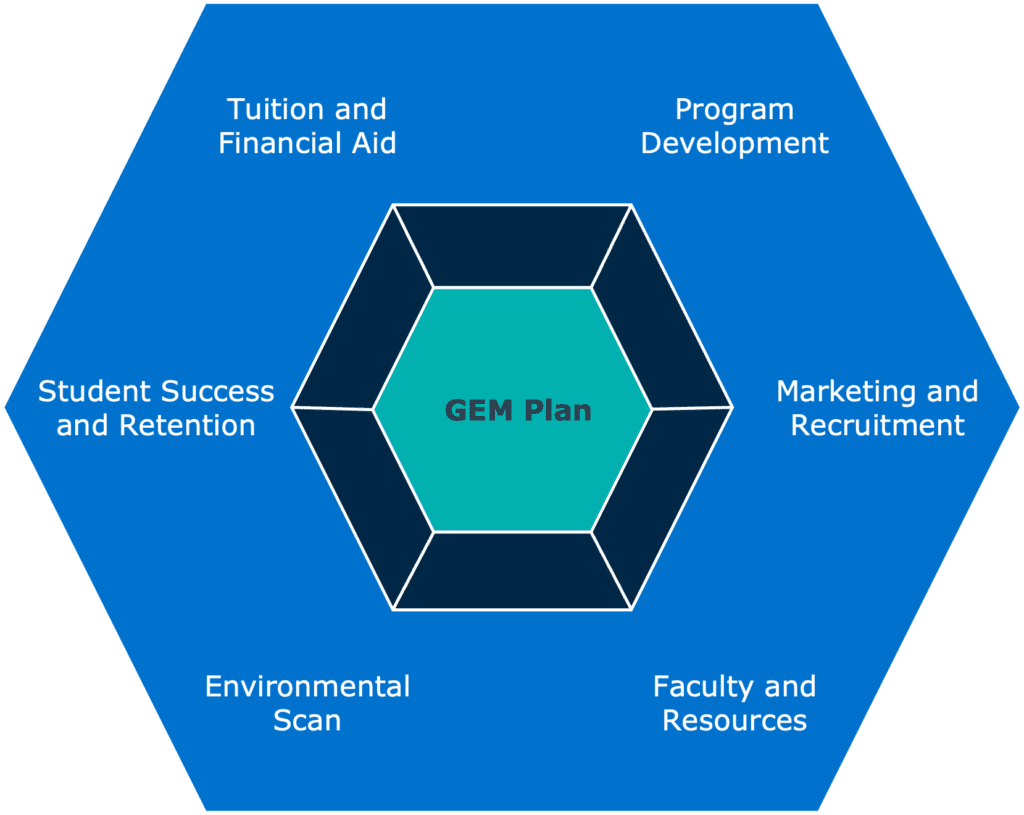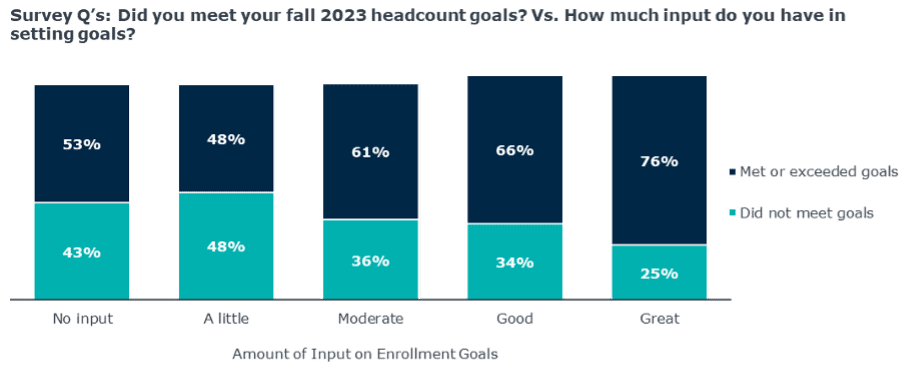Graduate enrollment goals are increasing—here are 3 strategies to keep up.
Top takeaways about meeting enrollment goals from EAB's latest survey with NAGAP
April 9, 2024, By Camilla Arias, Product Marketing, Senior Analyst
From the much talked about demographic cliff to the proliferation of Gen Z in the grad and adult market, population and demographic changes are making the graduate market even more competitive. These market headwinds are impacting the enrollment goals that graduate education leaders set for themselves, as well as their team’s ability to meet these goals.
To learn more about how these changes are impacting enrollment teams and their goals, our Adult Learner Recruitment team partnered with NAGAP, The Association for Graduate Enrollment Management, to survey nearly 250 enrollment leaders across the country in late 2023. We found that nearly 60% of graduate enrollment leaders surveyed faced increased enrollment and revenue goals. Meanwhile, almost 40% of respondents did not meet their headcount goals and 30% did not meet their revenue goals. With these trends in mind, here are three strategies your team can implement to best set and meet your graduate programs’ enrollment goals.
Explore the Full Survey Report
1. Improve transparency around enrollment goals and results
In the first report in our survey series, Future-proofing Your Graduate Operations, respondents shared that they want and need better communication from university leaders. Transparent communication eliminates barriers to inclusion by keeping faculty and staff informed about institutional decision-making and policy updates.
In this survey, participants revealed that attainment of net tuition revenue goals is one area of communication that institutions need to improve upon. While just 3% of participants were unsure if their institution met graduate headcount goals, 30% were unsure if they met their graduate NTR goals. The significant portion of respondents who are unaware of NTR goals and/or results speaks to the need for clear and transparent communication about revenue goals where applicable.
Review Our Toolkit on Communicating Decisions to Stakeholders
2. Build and invest in a graduate enrollment management plan
Our survey revealed that increasing enrollment was the biggest priority for graduate units in 2023 by a wide margin. With most graduate programs increasing goals year over year, it is crucial for teams to invest in a graduate enrollment management (GEM) plan.
Today’s GEM plan must adapt to the changing higher education landscape, including demographic shifts, new technologies, changing student perceptions of education, rising costs, and increased student debt. To accomplish this, enrollment goals and objectives cannot be created in a vacuum. They must also rely on the existing or redesigned infrastructure of the institution for input, feedback, and implementation.
Ensuring you have a realistic plan and goals (along with an adequate budget, faculty buy-in, and review process for your GEM plan) will allow your team to better avoid common enrollment pitfalls and realize the graduate growth you are seeking.
Key Pieces of a Successful Graduate Enrollment Management Plan

See How Georgia State University Adopted a GEM Plan to Meet Their Graduate Goals
3. Involve staff in the enrollment goal-setting process
In last year’s survey, we found that there was a positive correlation between graduate enrollment leaders’ input in goal setting and their performance in meeting those goals—a finding that proved true again in our most recent survey.
Over three-quarters of institutions whose graduate enrollment leaders had a great deal of input met and/or exceeded fall headcount goals, compared to only about half of programs whose leaders had little to no input. Simply put, the more input a survey respondent had in enrollment goal setting, the more likely they were to actually meet those goals.

If involving your staff in the goal-setting process can increase the likelihood of meeting your enrollment goals, it is worth considering whether this is an option for your team. Reflect on the following steps to set smart enrollment goals and consider where staff input and involvement may be most feasible and valuable.
-
1. Assess your current and historical enrollment data
-
2. Determine resource requirements
-
3. Analyze labor market and competitor data
-
4. Understand your current and ideal student types
By including a variety of people in the decision-making process, goals are less likely to be created in a vacuum and will benefit from a diverse set of perspectives and knowledge. Further, employees who feel a sense of ownership in the decision-making process often feel more engaged and invested in their work.
Review This Step-By-Step Guide to Set Smart Enrollment Goals
If your graduate programs’ headcount and/or revenue goals have increased, you are not alone. But whether you see this as a positive or a negative likely depends on the strategies you have in place to meet those goals.

More Blogs

What it takes to win in grad and adult enrollment today

Our new staffing model playbook for higher ed CMOs
